Renovating a bathroom can seem scary, but it can also be very rewarding. Looking back at my own bathroom renovation journey, I found key things that really matter.
A good renovation needs to understand design basics and use practical tips. For example, a timeless backsplash or green cabinets with gold hardware can make your bathroom look amazing. Using a bold color like deep teal paint can also make your bathroom stand out. By thinking about these points, you can make a bathroom that looks great and works well.
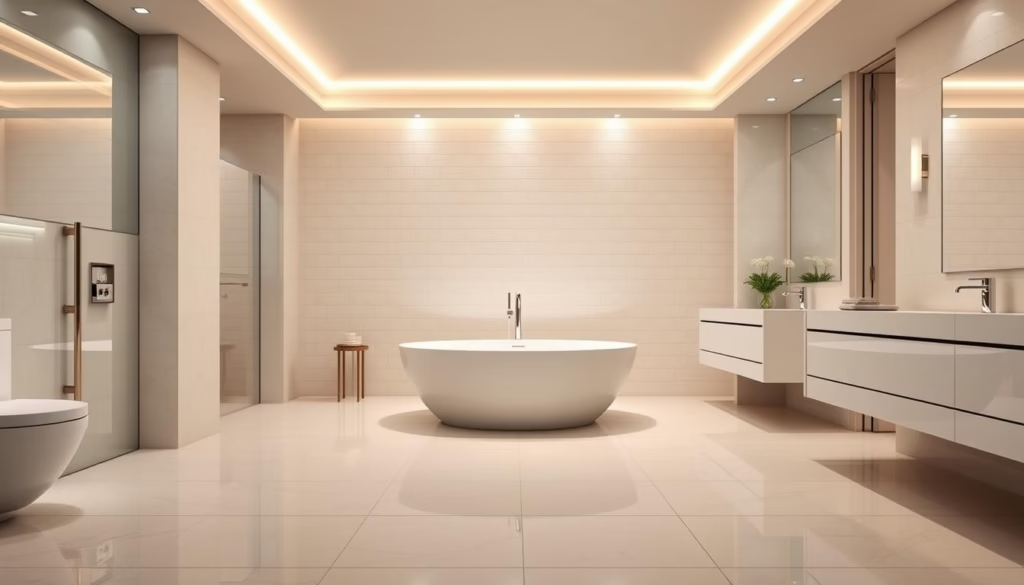
Key Takeaways
- Look at your current bathroom to see what needs to change.
- Add timeless design elements, like a timeless backsplash.
- Choose a bold color, like deep teal paint, for personality.
- Pick fixtures and hardware that match your design, like green cabinets with gold hardware.
- Get help from pros to make sure your renovation goes well.
The Bathroom Renovation Journey: What to Expect
Starting a bathroom renovation can be thrilling and scary. Knowing what to expect helps a lot. A good renovation needs planning, realistic hopes, and understanding the steps. Many people renovate their bathrooms for the money it can make back. Bathroom makeovers often bring in a lot of return on investment, making them a smart choice for homeowners, whether upgrading a kitchenette with dishwasher or a bathroom with a lake retaining wall view.
Why Bathroom Renovations Deliver High ROI
Bathroom makeovers can really boost a home’s value. Studies show a well-done bathroom makeover can make back up to 60% of its cost. This is because a modern, working bathroom is something buyers really want. For example, adding a timeless kitchen backsplash in an adjacent space or green kitchen cabinets with gold hardware can enhance overall home appeal.
| Renovation Element | Average Cost | ROI |
|---|---|---|
| Tile and Flooring | $3,000 – $5,000 | 50% – 70% |
| Fixtures and Fittings | $2,000 – $4,000 | 40% – 60% |
| Vanity and Storage | $1,500 – $3,000 | 30% – 50% |
Setting Realistic Expectations and Timelines
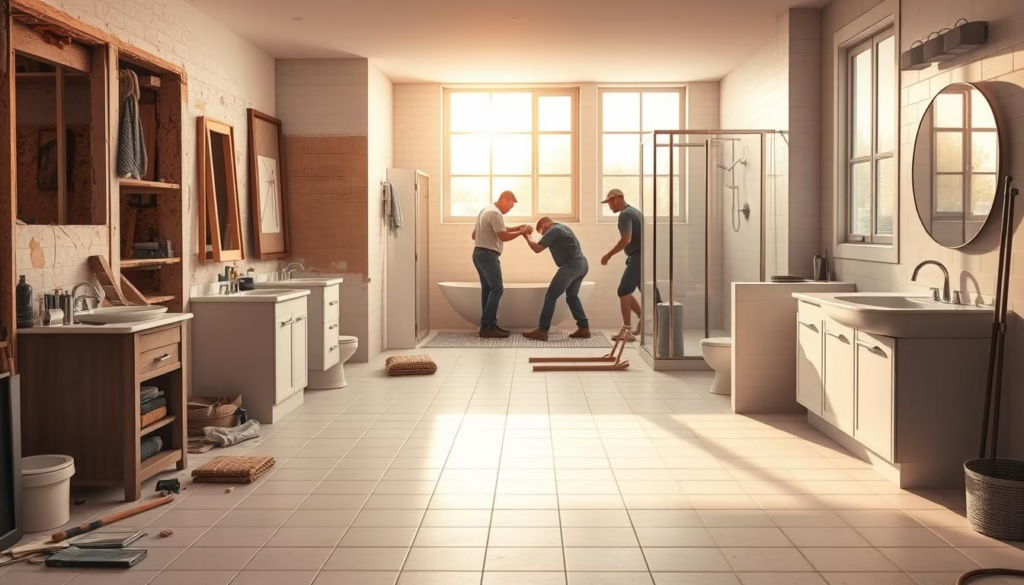
It’s key to have realistic hopes and timelines for a bathroom makeover. Renovations can be complex and might face unexpected hiccups, like a water heater making hissing noise or a need to fix a main water line leak. A typical bathroom makeover takes 2 to 6 weeks, depending on the project’s size, whether it involves a shower drain for shower pan or complex plumbing like a sewer house trap diagram.
Assessing Your Current Space Before Starting
Before starting a bathroom renovation, it’s key to check your current space. This step helps spot issues, understand your needs, and plan better, whether you’re upgrading a 2200 sq feet house plans or a smaller bathroom.
Identifying Problem Areas and Pain Points
Walk through your bathroom and list any problems. Look for leaks, water damage, a toilet hairline crack, or a cracked toilet bowl base, which require immediate replacement. Think about your bathroom’s layout—cramped spaces or inefficient flow may need reconfiguring, similar to planning a chicken house and run plans for optimal space use.
Taking Accurate Measurements for Planning
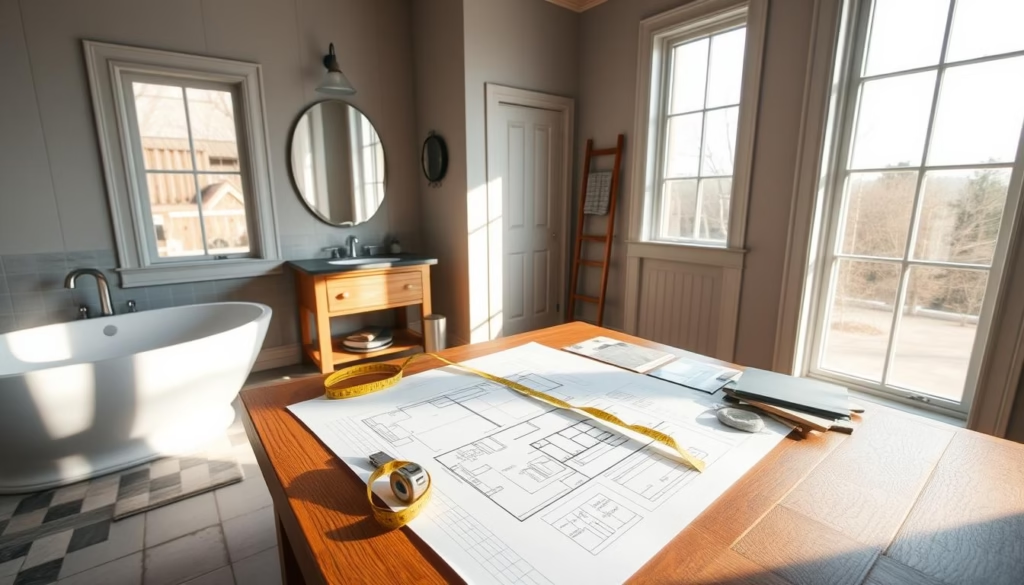
To plan well, measure your bathroom accurately. Note its length, width, and height, aligning with the average living room size (340 square feet) for adjacent spaces. Measure fixtures like sinks and toilets, ensuring a bathtub standard size (60″ x 30–32″) fits. Use these to draw a scale plan, accounting for plumbing rough-in heights (toilet: 15″, sink: 18–20″, shower: 48″).
| Fixture | Standard Size | Your Measurement |
|---|---|---|
| Bathtub | 60″ x 30″ | Measure Here |
| Shower | 32″ x 32″ | Measure Here |
| Sink | 24″ x 18″ | Measure Here |
Creating a Comprehensive Renovation Budget

Creating a realistic renovation budget is key for a successful bathroom renovation. A good budget helps you use resources wisely, whether for a bathroom or a lake retaining wall project.
Typical Cost Breakdown for Bathroom Projects
A typical bathroom renovation cost includes plumbing fixtures, tiles, vanity, lighting, and labor. On average, labor is 30%, plumbing (e.g., flexible pipes for plumbing or black roll pipe) 20%, tiles and flooring 15%, and other components 35%. Consider how much does siding cost for a house (vinyl: $8,000–$14,000; hardiplank: $16,000–$24,000 for 2,000 sq ft) if exterior upgrades are involved.
Building in a 15-20% Contingency Fund
A contingency fund (15–20% of your budget) covers unexpected costs like a water heater pressure valve dripping or japanese knotweed removal cost. For a $10,000 budget, set aside $1,500–$2,000 to handle issues like mould in toilet tank or material delays.
Lesson 1: Prioritizing Functionality in Your DESIGN
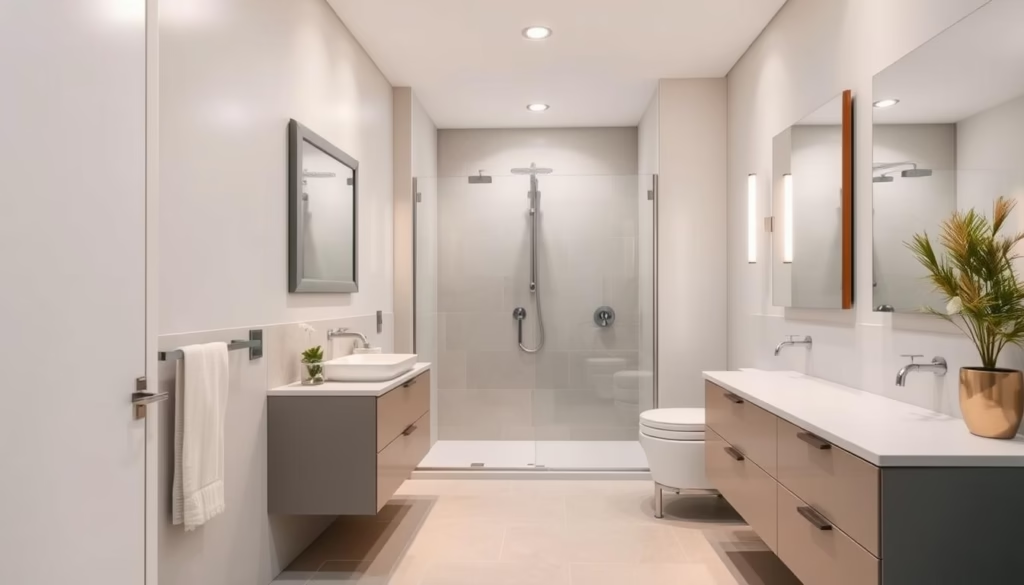
In bathroom design, looks and function are both key. A good bathroom should be stylish and easy to use, whether it’s a small space or part of a 2200 sq feet house plans.
Space Planning and Traffic Flow Fundamentals
Space planning ensures easy movement, using the “work triangle” of sink, toilet, and shower. This mirrors planning an average living room (340 square feet) for efficient flow. Consider a pocket door framing detail to save space, using an actual measurement of a 2×6 (1.5″ x 5.5″) for framing.
Standard Dimensions and Clearances
The NKBA recommends 32 inches between fixtures for safety and comfort. This applies to a shower drain for shower pan or a bathtub standard size (60″ x 30–32″). A gang box metal for electrical outlets ensures safe wiring.
Accessibility Features Worth Including
Incorporate grab bars, curbless showers, and lazy susan cabinet sizes for easy storage access. These make the bathroom user-friendly, much like a bar stool blueprints design prioritizes comfort.
Lesson 2: Selecting Timeless Fixtures and Materials
Choose timeless fixtures and materials for a lasting, stylish bathroom, avoiding trendy pitfalls like a popcorn ceiling.
Choosing Quality Over Trends
Quality fixtures outlast trends, as Laura Ashley noted: “A room should never be just decorated, it should be lived in.” Opt for durable materials like engineered wood vs laminate or MDF v chipboard for vanities, and use cherry stains for wood or a timeless backsplash (subway tiles, natural stone) for elegance.
Timeless Backsplash and Tile Options
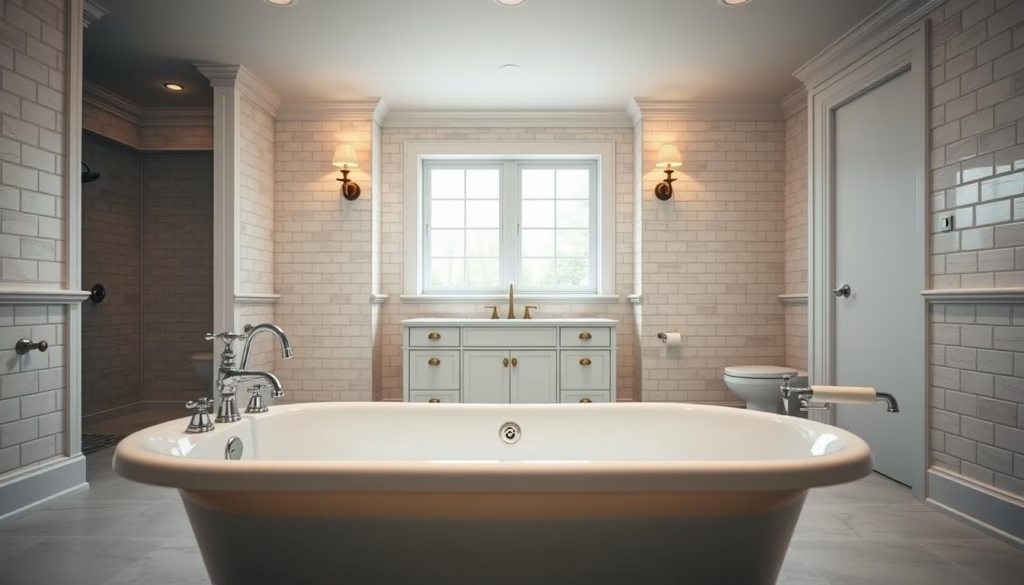
Subway tiles, marble, or ceramic tiles are durable and versatile, ideal for a backsplash with cherry cabinets or a timeless kitchen backsplash in adjacent spaces. Avoid cellulose sponge cloth for cleaning due to bacteria breeding ground risks—use microfiber vs polyester cloths.
| Material | Durability | Aesthetic Appeal |
|---|---|---|
| Natural Stone | High | Classic, Elegant |
| Ceramic Tiles | High | Versatile, Timeless |
| Glass Tiles | Medium | Modern, Reflective |
Fixture Selection Guidelines
Choose bathtubs (60–72″ long), sinks, and faucets for function and style. A stainless steel shower drain for shower pan prevents rust. Use weep screeds for proper drainage in tiled areas.
Lesson 3: Mastering Bathroom Storage Solutions
Storage keeps your bathroom clutter-free and functional, enhancing daily use.
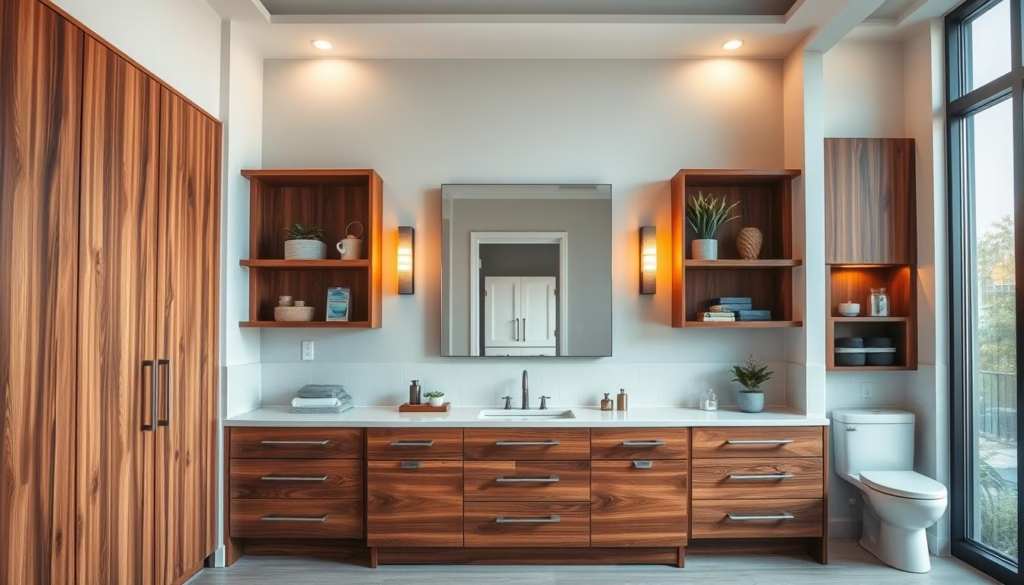
Vanity Cabinet Sizes and Configurations
Vanities (24–72 inches) offer drawers, shelves, or cabinets. Wall-mounted vanities save space, while a lazy susan cabinet sizes optimize corners, similar to purse pillows for organized storage.
Lazy Susan Cabinet Options for Corners
Rotating Lazy Susan cabinets maximize corner space, ideal for small bathrooms. Adjustable shelves accommodate toiletries, much like a chicken house and run plans optimizes space.
Creative Niches and Built-In Storage
Niches in showers or recessed medicine cabinets add storage without sacrificing style, enhancing functionality like a black white stair runner adds visual appeal to a staircase.
Lesson 4: Creating Proper Lighting Layers
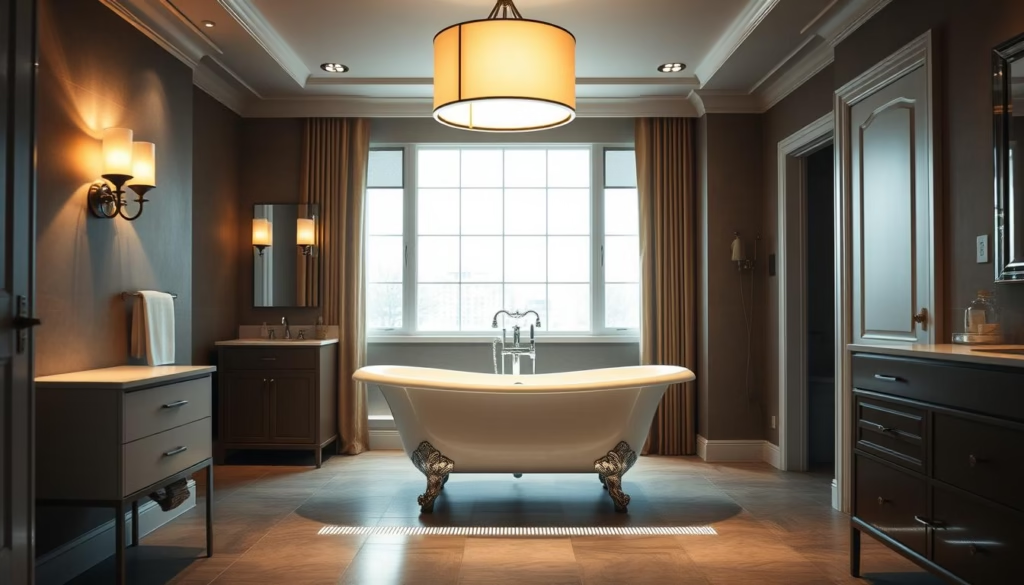
A well-lit bathroom combines task, ambient, and accent lighting for function and ambiance, avoiding the outdated look of a popcorn ceiling.
Task Lighting for Grooming Areas
LED sconces by the vanity reduce shadows, ideal for grooming. Ensure electric panel parts and line versus load wire (line: power in; load: power out) are correctly installed by an electrician for safety, as a sub panel may be needed for additional circuits.
Ambient Lighting Strategies
Ceiling or recessed dimmable lights set the tone, complementing cottage wall decor or staircase wall wallpaper in nearby spaces.
Accent Lighting for Visual Interest
Highlight a timeless backsplash or freestanding tub with accent lighting, using energy-efficient LEDs for a luxurious feel.
Lesson 5: Ventilation and Moisture Management
Ventilation and moisture management prevent mold and mildew, ensuring a healthy bathroom.
Selecting the Right Exhaust Fan Size
Choose a fan that exchanges air 8 times per hour (e.g., 800 CFM for a 200 cubic feet bathroom). This prevents issues like mould in toilet tank or a basement floor temperature winter Michigan forum concern.
| Bathroom Volume (cubic feet) | Required CFM |
|---|---|
| 100 | 800 |
| 200 | 1600 |
| 300 | 2400 |
Waterproofing Critical Areas
Use waterproof membranes and hydraulic cement for showers and sinks to prevent leaks, ensuring proper drainage with weep screeds.
Preventing Mold and Mildew Issues
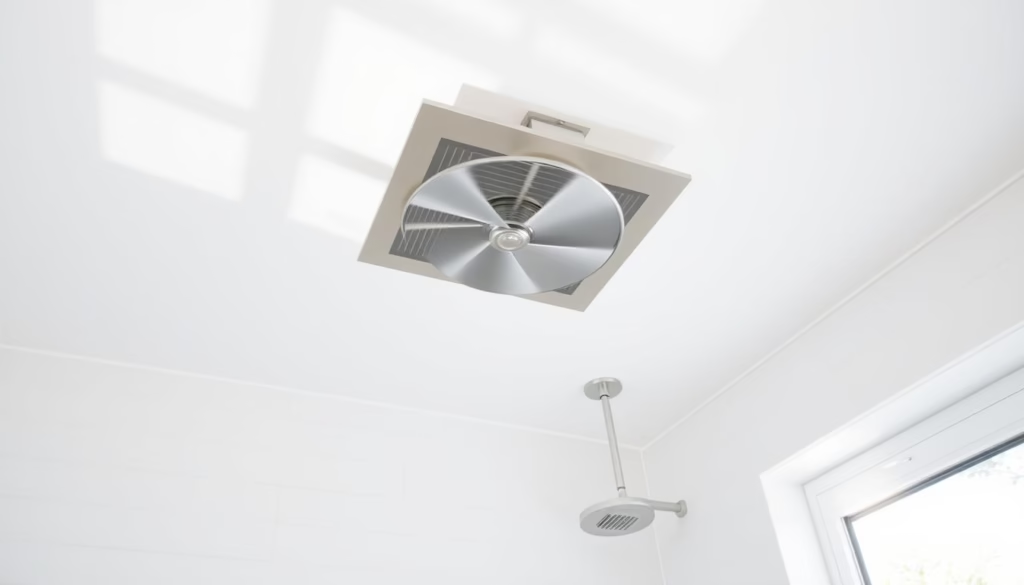
Run exhaust fans during showers and clean surfaces with microfiber cloths, not a cellulose sponge cloth, to avoid bacterial spread. Fix issues like a water heater making hissing noise promptly.
Lesson 6: Color and Material Coordination
A cohesive color and material scheme creates a luxurious bathroom.
Creating a Cohesive Color Palette
Choose calming blues or cozy terracotta, pairing with deep teal paint for boldness. Clever color names like “Moody Indigo” inspire choices.
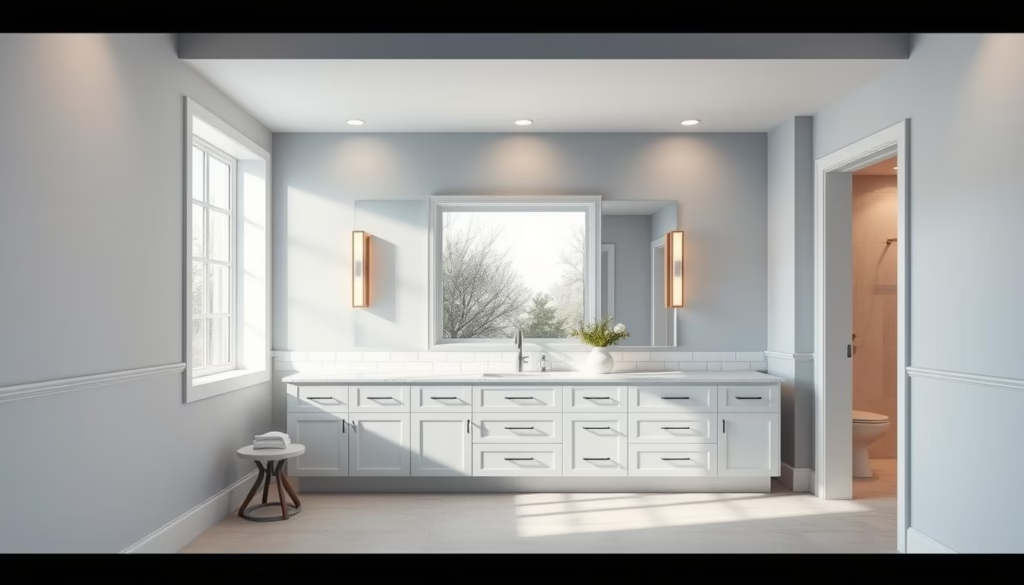
Deep Teal Paint and Bold Color Options
Deep teal paint adds luxury, balanced with neutral tones to avoid overwhelming the space, complementing green cabinets with gold hardware.
Green Cabinets with Gold Hardware Trend
This trendy combination adds freshness and class, pairing well with a black white stair runner or American flag beach towel in adjacent spaces.
Balancing Hard and Soft Surfaces
Mix hard surfaces (tile, stone) with soft ones (rugs, towel sizes like bath sheets: 40×70″; towels: 30×56″) for warmth, adding plants like Alocasia morocco for air quality.
| Surface Type | Examples | Tips for Balancing |
|---|---|---|
| Hard Surfaces | Tile, Stone | Use soft textiles or plants |
| Soft Surfaces | Rugs, Towels | Balance with hard surfaces |
Lesson 7: Incorporating Personal Touches
Personal touches make your bathroom a reflection of your style, enhancing its oasis-like feel.
Accessorizing Your Bathroom Effectively
Add a single rose vase, decorative mirror, or purse pillows for flair, complementing cottage wall decor.
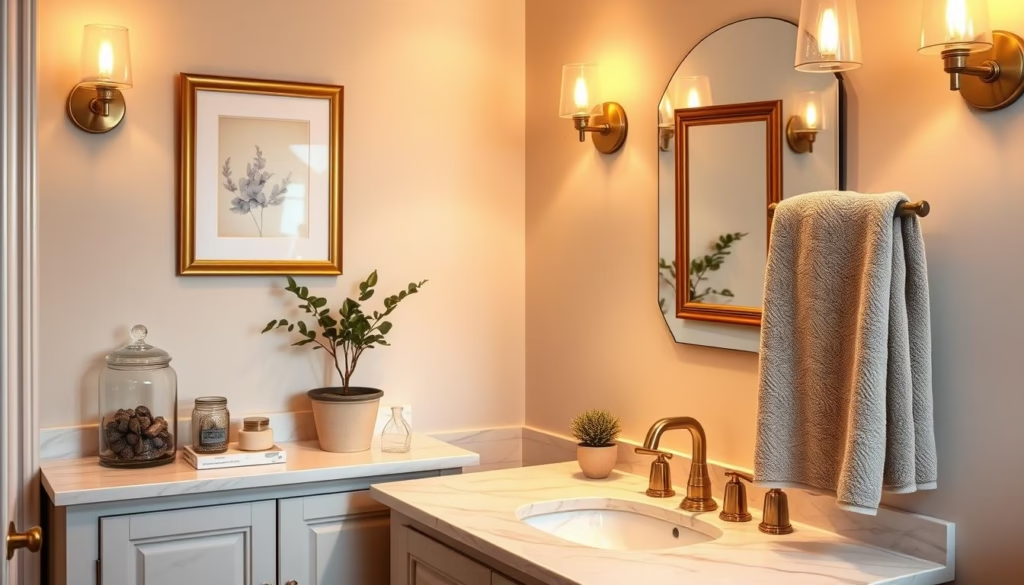
Art and Decorative Elements
Hang art or use staircase wall wallpaper for visual interest, ensuring items are moisture-resistant.
Plants That Thrive in Bathroom Environments
Humid bathrooms suit hanging asparagus fern, tropical hanging baskets, or low-maintenance options like Begonia Red Robin, Samurai Toad Lily, Glauca Pilea, Alocasia Morocco, Alocasia Dragon Scale, Alocasia Sarian, Black Velvet Alocasia, Maharani Alocasia, Ficus Shivereana, Philodendron Splendid, Philodendron Dark Lord, Scindapsus Exotica, Aglaonema Pictum, Anthurium Hawaii, Anthurium Seedling, Dracena Florida Beauty, Florida Green Philodendron, Florida Philodendron, or Yellow Kalanchoe Plant. Good plants around a pool, like Phoenix Roebelenii or pink flowering bushes in Florida, inspire outdoor-adjacent designs. How long can a flower live without water? About a week, so mist regularly.
Hanging Asparagus Fern and Tropical Options
Hanging asparagus fern and orchids thrive in humidity, adding lushness like a lisianthus white flower or hawaiian red flower.
Low-Maintenance Bathroom Greenery
Snake plants or ZZ plants need minimal care, ideal for busy homeowners, similar to a large juniper bonsai tree or mounted staghorn fern.
Working With Professionals: When and Who to Hire
Professionals ensure a smooth renovation, from plumbing to electrical work.
When to Bring in a Designer
A designer optimizes layout and materials, recommending timeless backsplash options or green kitchen cabinets with gold hardware.
Selecting Qualified Contractors
Choose licensed, insured contractors with bathroom experience. Check references for reliability, especially for tasks like pouring concrete in cold weather or installing a compass concrete stamp.
| Criteria | Contractor A | Contractor B | Contractor C |
|---|---|---|---|
| Experience | 10 years | 5 years | 15 years |
| License | Yes | Yes | Yes |
| Insurance | Yes | No | Yes |
| Customer Rating | 4.5/5 | 4.0/5 | 4.8/5 |
Questions to Ask Before Hiring
Ask about experience, workflows, and materials (e.g., sheetrock screws vs wood screws, drywall screws sizes: 1-1/4″ for screw size for 1/2 drywall; 1-5/8″ for 5/8 drywall). Inquire about hydraulic cement for waterproofing or weep screeds for drainage.

DIY vs. Professional Work: What You Can Tackle Yourself
Balance DIY and professional tasks based on skill and complexity.
Projects Suitable for DIY Enthusiasts
DIY tasks include demolition, painting (e.g., deep teal paint), installing faucets, or tiling with a German saw. Clean surfaces with microfiber cloths, not a kitchen sponge, to avoid bacteria.
When to Leave It to the Professionals
Hire pros for major plumbing (e.g., fix main water line leak), electrical work (e.g., 240 volt wiring diagram, line versus load wire, sub panel installation), or structural changes. Professionals prevent costly errors, like a tripped circuit breaker or blown fuse due to faulty electric panel parts.
Essential Tools for DIY Bathroom Projects
| Tool | Use |
|---|---|
| Tape Measure | Accurate measurements |
| Level | Ensuring level surfaces |
| Pliers/Wrenches | Handling pipes/fixtures |
| Tile Cutter/German Saw | Cutting tiles precisely |
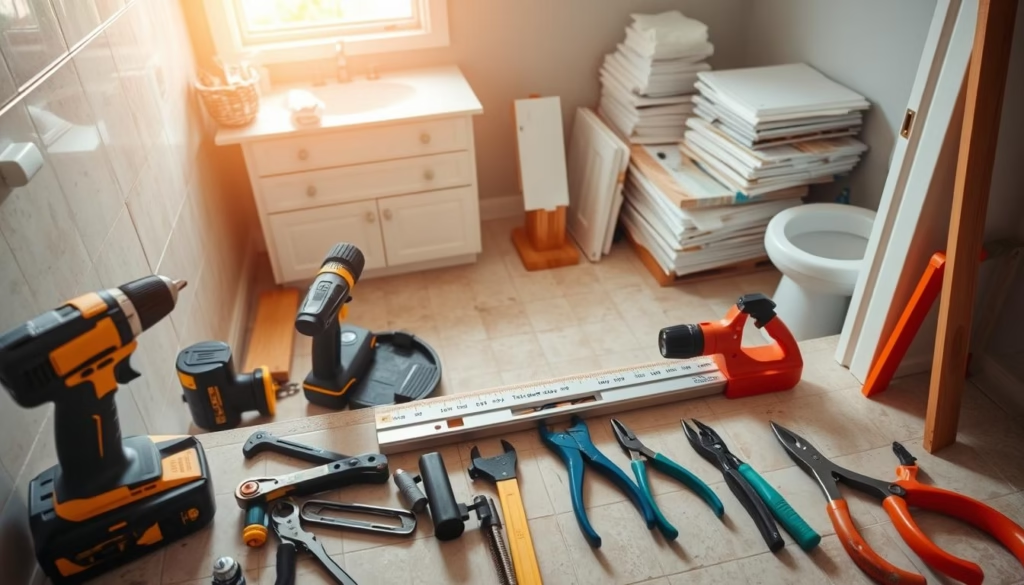
Navigating Common Renovation Challenges
Anticipate challenges to keep your project on track.
Dealing With Unexpected Plumbing Issues
Old pipes or a water heater pressure valve dripping can delay progress. Have a plumber inspect systems, including flexible pipes for plumbing or a sewer house trap diagram, before starting.
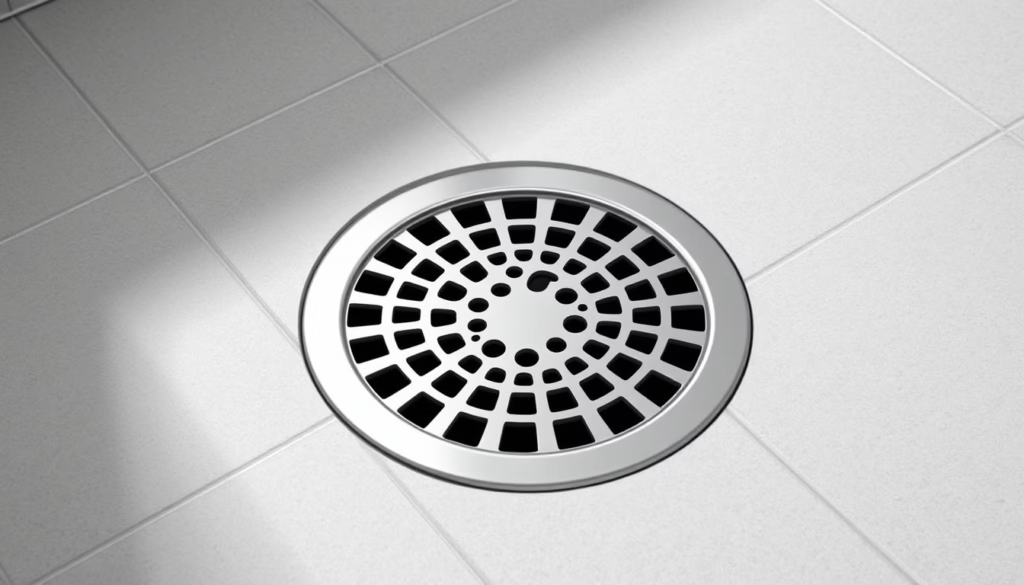
Managing Timeline Delays
Create a detailed schedule with wiggle room for delays, like waiting for a timeless backsplash or dealing with japanese knotweed removal cost. Communicate with contractors regularly.
Solving Space Constraints in Small Bathrooms
Use wall-mounted fixtures, mirrors, and light colors (e.g., deep teal paint balanced with neutrals) to maximize space, similar to rug size for bedroom with queen bed (8×10 feet recommended).
Sustainable and Eco-Friendly Bathroom Options
Sustainable choices reduce environmental impact while enhancing style.
Water-Saving Fixtures and Features
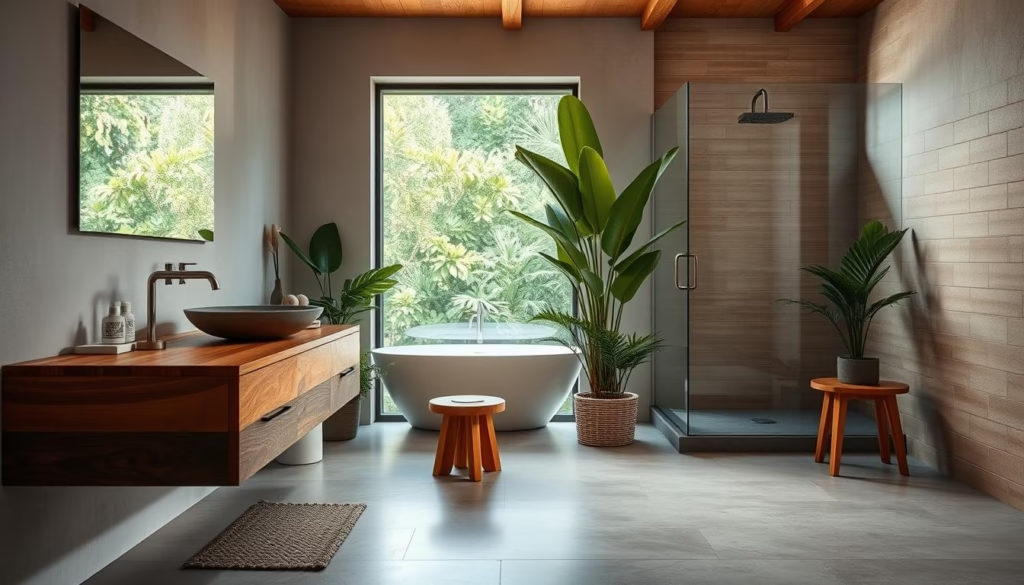
Low-flow toilets (1.6 gallons/flush) and showerheads save water, complementing good plants around pool like Phoenix Roebelenii for outdoor areas.
| Fixture | Water Consumption | Water Savings |
|---|---|---|
| Low-Flow Toilet | 1.6 gallons/flush | Up to 4.8 gallons/flush |
| Conventional Toilet | 6.4 gallons/flush | – |
Energy-Efficient Lighting and Heating
LED lights cut energy use by 80%, ideal for task or ambient lighting. Radiant floor heating, controlled via a sub panel, is efficient, avoiding EMHEAT overuse.
Sustainable Material Choices
Use bamboo, reclaimed wood, or low-VOC paints like deep teal paint. Plants like Artemisia Garden Ghost or Gaura Passionate Blush enhance air quality, mirroring graziella maiden grass or electric love weigela in gardens.
Maintaining Your Newly Renovated Bathroom
Regular care keeps your bathroom pristine, avoiding issues like why is grass turning yellow (overwatering or nutrient deficiency) in nearby lawns.
Daily and Weekly Cleaning Routines
Wipe surfaces daily to prevent soap scum. Weekly, scrub showers and toilets with best homemade laundry soap recipe (borax, washing soda, soap) for eco-friendly cleaning, avoiding microfiber vs polyester debates. To clean leather gloves or a silk tie, use a damp cloth with mild soap, not a sponge. For an antique quilt or chalkboard, gently vacuum or wipe with a dry cloth.
Preventative Maintenance Tips
Check seals around showers and bathtubs, using hydraulic cement for repairs. Monitor plumbing for a water heater making hissing noise or mould in toilet tank, and use a gypsy moth catcher for outdoor pest control.
Cleaning Different Surface Materials
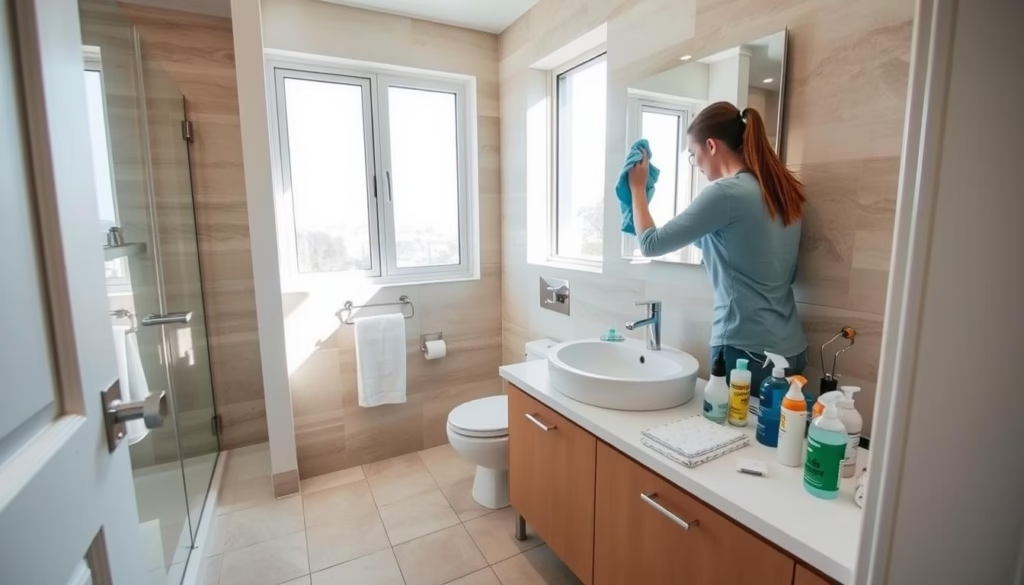
Marble needs pH-neutral cleaners; ceramic tiles handle stronger solutions. To get paint off laminate flooring, use rubbing alcohol, not vinegar, which kills spiders in seconds (how long does vinyl siding last: 20–40 years, similar to laminate).
Conclusion: Transforming Your Bathroom Vision into Reality
Success comes from careful planning and attention to DESIGN. Features like a timeless backsplash, green cabinets with gold hardware, or plants like Alocasia Sarian create a stunning space. Stay flexible, seek professional help for complex tasks like a 240 volt wiring diagram, and maintain hygiene with microfiber cloths to avoid the bacteria breeding ground of a kitchen sponge. Your bathroom will become a peaceful oasis that exceeds your dreams.
Additional Tips for Home and Garden
- Plants: Incorporate Ruby Sunset Maple, Emerald Queen Maple Tree, or small maple tree leaves for outdoor appeal. Tropical hanging baskets, Begonia Red Robin, or Yellow Kalanchoe Plant thrive indoors. Plants to plant around a pool include Plectranthus Lemon Twist or Siberian wallflower (invasive, so manage carefully). Tecoma Stans seeds or 4 o’clocks from seed add garden color.
- Outdoor Maintenance: Vinyl siding lifespan is 20–40 years; clean with a brush, not a sponge. A lake retaining wall or compass concrete stamp enhances landscapes. Do you need a permit to put brick driveway? Check local regulations. How do you hang things on cinder block walls? Use masonry anchors.
- Decor: Cottage wall decor, black white stair runner, or American flag beach towel add charm. Towel sizes (sheets: 40×70″; towels: 30×56″) complement storage. Como quitar el olor a pipi del colchon? Use baking soda and vinegar.
- Miscellaneous: How to keep mice away from camper (seal entries, peppermint oil) applies to storage areas. How long does laminate flooring last (15–25 years)? Maintain with care. Insects that look like ants with wings (termites vs ants) require pest control. Canadian hemlock growth rate is slow, ideal for privacy. Bar stool blueprints or large juniper bonsai tree inspire DIY projects. How to wash 100 cotton involves cold water to prevent shrinking.
FAQ
What is the average size of a living room?
About 340 square feet, guiding adjacent space planning.
How long does vinyl siding last?
20–40 years, depending on maintenance.
How do you clean leather gloves?
Use a soft cloth with mild soap, then condition.
What are the standard dimensions for a bathtub?
60 inches long, 30–32 inches wide.
How do I prevent mold and mildew in my bathroom?
Ensure ventilation, waterproof areas, and clean regularly.
What is the importance of a contingency fund in a renovation budget?
A 15–20% fund covers unexpected costs.
How do I choose the right exhaust fan size for my bathroom?
Base it on bathroom volume and CFM rating (e.g., 800 CFM for 200 cubic feet).
What are some timeless backsplash and tile options?
Subway tiles, marble, natural stone.
How can I incorporate personal touches into my bathroom renovation?
Use art, decor, and humidity-tolerant plants.
What are some low-maintenance bathroom greenery options?
Hanging asparagus fern, snake plants, ZZ plants.
When should I hire a professional for my bathroom renovation?
For plumbing, electrical, or structural tasks.


Leave a Reply